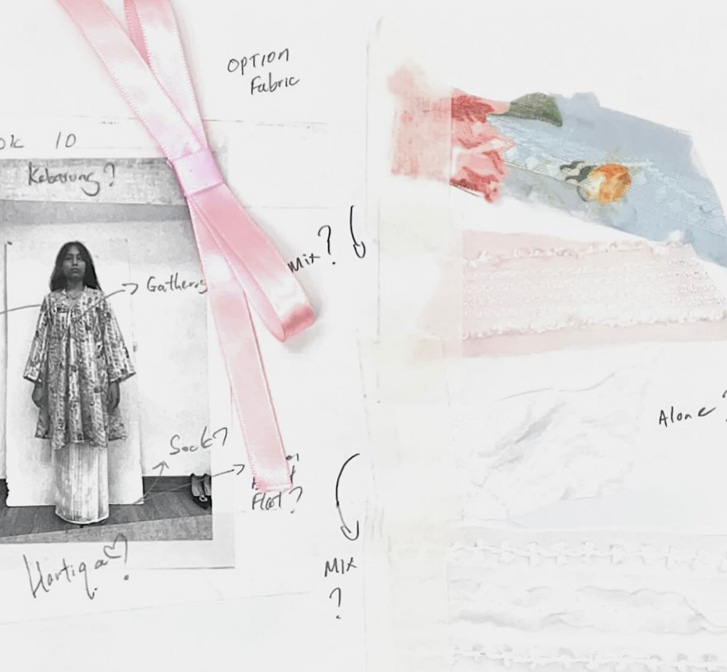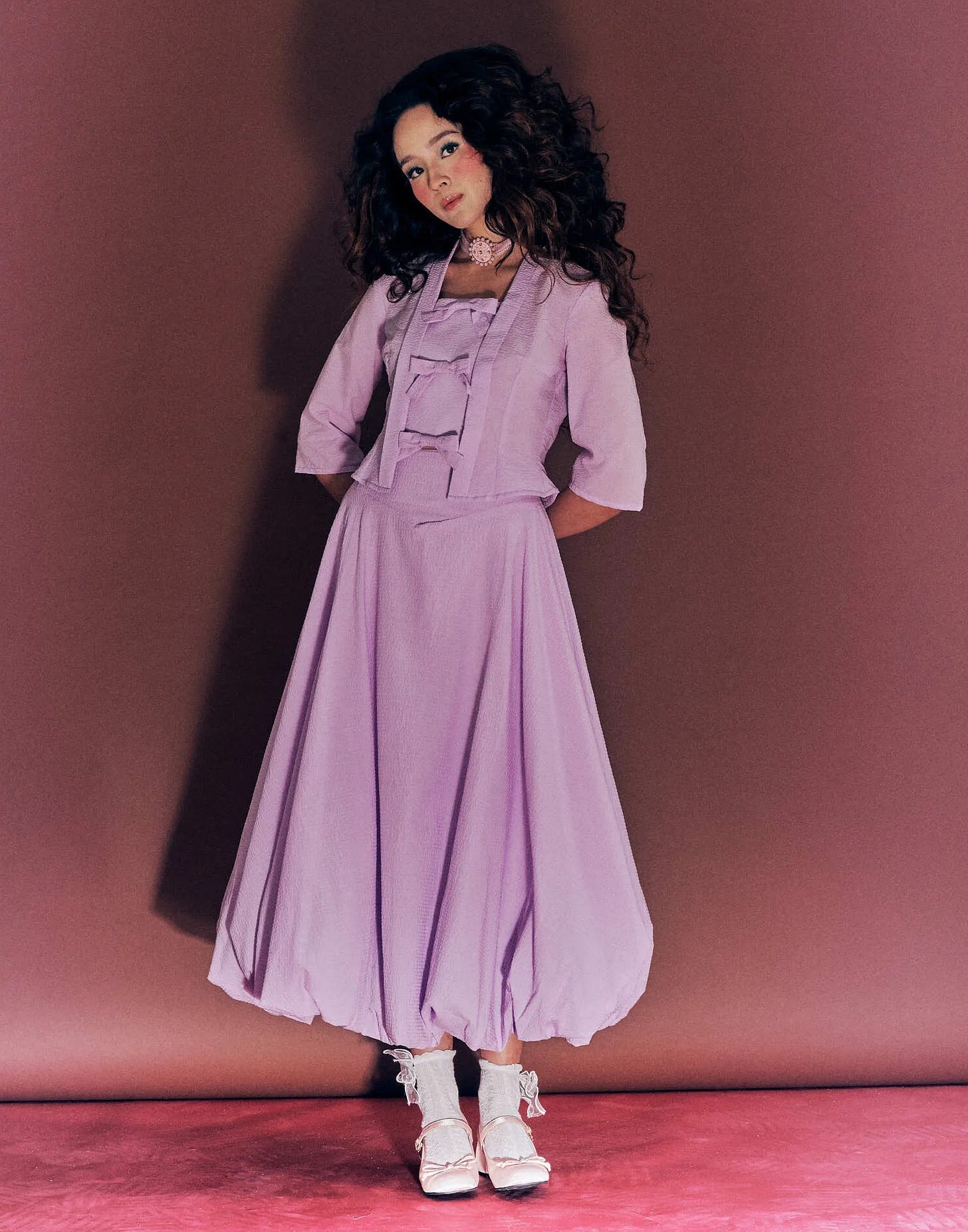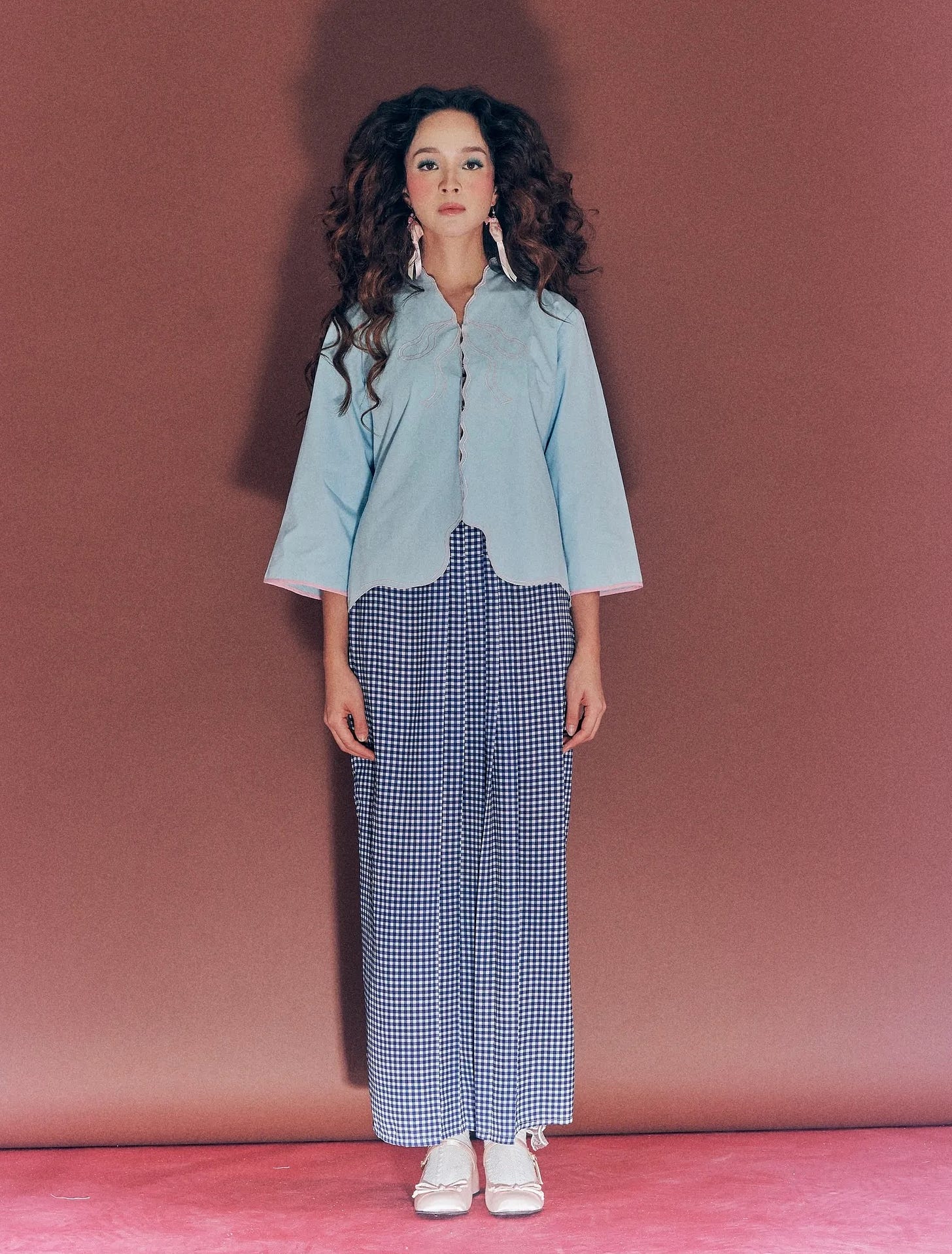Messy Conversations: Rumah Hartiqa
Chatting with Rafiz Razali on starting a new brand and being a young designer in Malaysia.
The internet has become oversaturated with content. A simple search of “clean girl aesthetic” on Google will see millions of results returned to you. Do the same on TikTok and you will find more than 200,000 videos on the subject.
I would not say that this is necessarily a bad thing because, hey, more things for me to consume on my daily bedrot, right? But it does make being on the internet a monotonous affair and at some point, utterly boring. Hard for it not to be when my algorithm is so hung up on force-feeding me the same iteration of contents every single time. I can’t go two seconds without seeing some ad from some brand plastered on my screen and hearing some trending audio play repetitively out of my speaker.
So, it’s a sort of miracle when Rumah Hartiqa fell into my lap (explore page). Here, on this quiet February evening, a thrilling discovery has been made. As I stalk their pink-hued and Coquettified Instagram feed, my faith in the algorithm – and in the local fashion scene – is restored.
On the 7th of February, I had the pleasure of sitting down with Rafiz Razali, designer of Rumah Hartiqa, to discuss the brand and his experience as a young designer and entrepreneur.
P.S. This is NOT an ad, I just really like their stuff.
Who is Rumah Hartiqa?
It was a sultry Wednesday afternoon. I was fiddling with my laptop and trying to calm both my nerves and excitement when I saw Rafiz’s name pop-up in the corner of my laptop screen, requesting me to let him in the call. I could see that he was in his studio, pieces of colourful fabric glowed brightly behind him. We exchanged niceties and got into the groove of the interview.
Having graduated from Kolej Vokasional ERT Setapak in Fashion Design, Rafiz established Rumah Hartiqa back in 2022 with three of his college mates. He wanted to take traditional outfits out of its comfort zone and make them more modern, experimental, and suitable for everyday wear, and so Rumah Hartiqa was born.
But getting there was not exactly easy.
When asked about his entrepreneurial journey thus far, Rafiz admits that it has not been without some challenges – funding and manpower being some of them. To register a company already costs thousands of ringgit. Then there’s rent, employee expenses, production costs, etc. Now, imagine digging into your own packet to pay for all of that. Well, that’s exactly how Rumah Hartiqa does it: Rafiz and his dad keeps the brand afloat financially.
So, to keep costs low, the young designer and three other members of the brand, Haziq, Wawa, and Mimi, do everything on their own from designing to production to marketing and PR. Despite this massive feat, they are passionate about what they do at Rumah Hartiqa; every piece of clothing that is sewn and delivered is a labour of love.
Unfortunately, not everyone has come to appreciate their efforts. When asked about support from the local fashion industry, Rafiz tells me that he wishes they were a little bit more supportive of small businesses. He finds some of them to be quite exploitive, taking advantage of small businesses just because they are, well, small. I was horrified to hear stories of payments not being made and items not being returned after they have been kindly loaned for a shoot. How can we expect our local fashion scene to prosper when the industry itself fails to provide adequate support for up-and-coming designers?
While he may have encountered some unsavoury experiences within the industry, Rafiz remains hopeful, stating his wishes to turn Rumah Hartiqa into an established fashion house, and to see his clothes worn by Hollywood stars. He is also grateful for the support he’s been receiving from the general public, especially towards their latest Eid collection.
About the collection
Their latest collection, befittingly named Coquette Raya, is a coquette girl’s Pinterest moodboard come to life. Painted in adorable hues of pastels with ribbons, ruches, and glitter decorating the garments, this collection was never actually meant to be so coquette. Rafiz knew he wanted to put a cute and fun twist to traditional baju kurung and kebaya silhouettes, but only thought to go with the coquette theme when he was styling his designs for a shoot.
He confessed that he isn’t even a huge fan of the coquette aesthetic, but he knows that’s what the people want, and with that he delivered!
He was actually inspired by the Libon Kurung, a piece from his previous Eid collection, hence the ribbons and girlish silhouettes. But unlike the previous collection – which was more theatrical and extravagant – this one has a casual flair to it, making it ideal for everyday wear too.
And if you ask me, that makes paying RM300++ for these pieces worth it. Not only will I get to maximise my cost per wear because I can wear them outside of open houses and weddings, but I am also supporting the labour and creative endeavour of young Malaysian designers. That’s right, each piece is personally sewn by Rafiz, Haziq and Wawa.
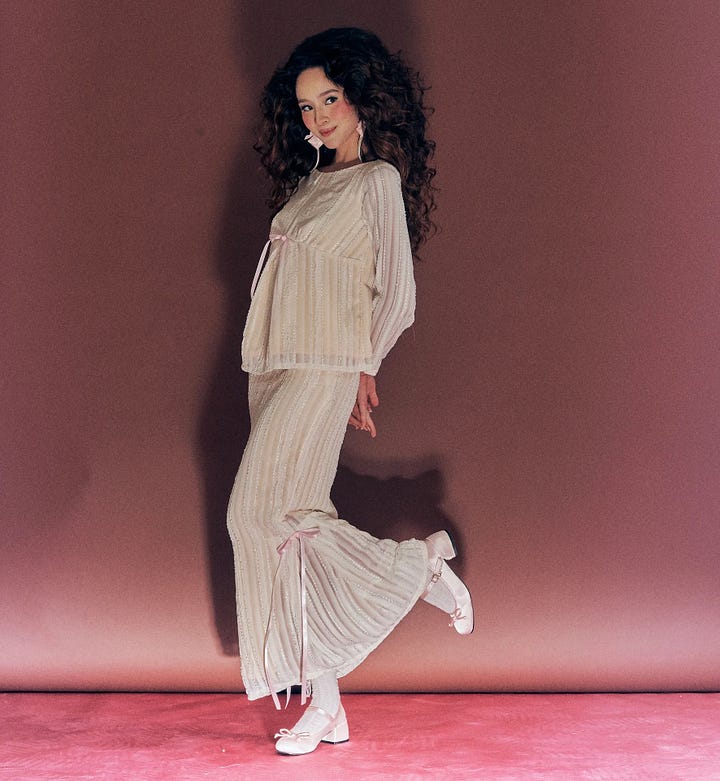

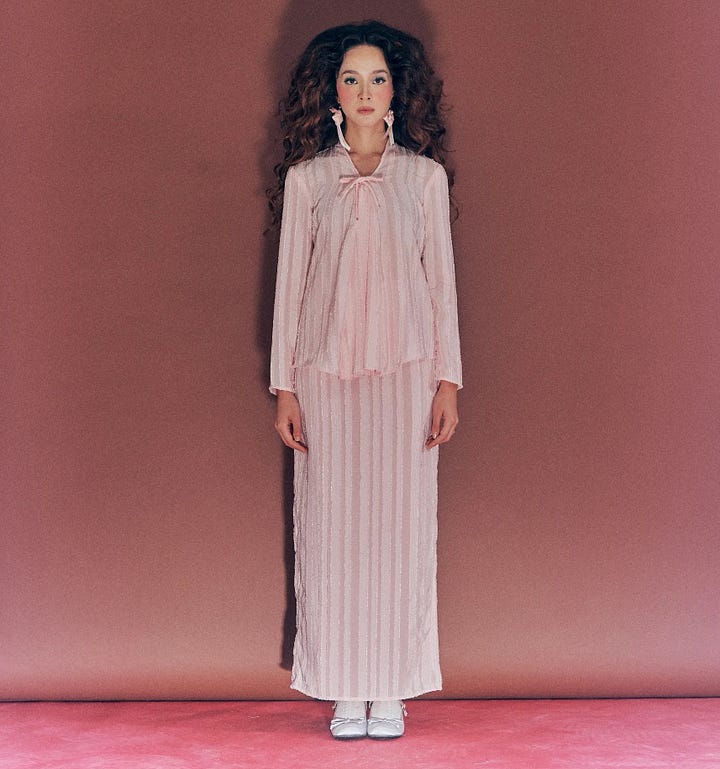
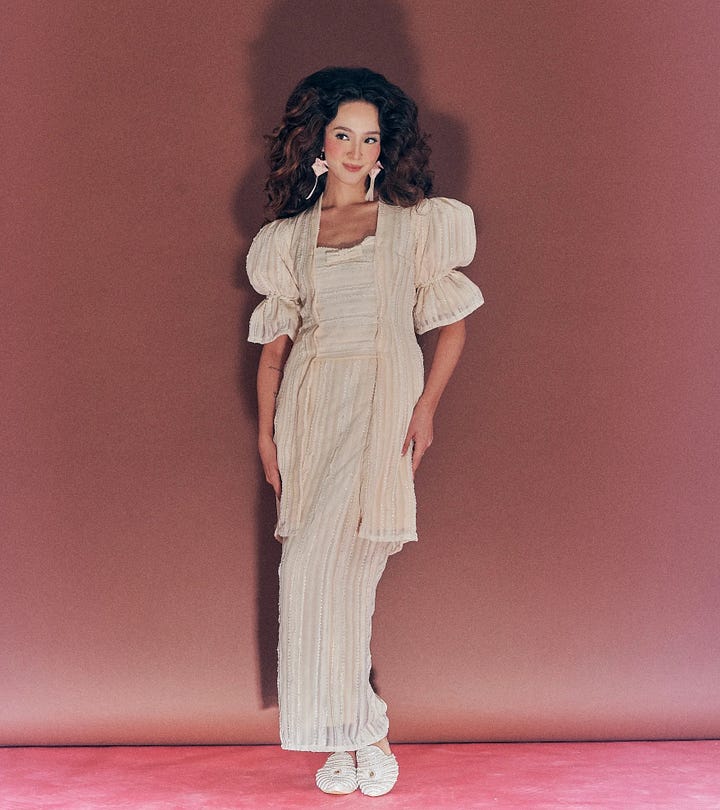
Besides it being very coquette, it is obvious that Rafiz also drew upon vintage styles as inspiration for this collection. I could see hints of the 40s through the babydoll silhouettes and the 80s through the ruching and voluminous sleeves. I think I’ve seen an old photo of my mom and aunties in something like this before. One piece in particular, the Maria Kebaya, reminds me of a toned-down take on the Rococo.
If one of your top four movies on Letterboxd is Sofia Coppola’s Marie Antionette, The Virgin Suicides or Priscilla, then this collection would speak to you.
I had the pleasure of trying on some of the pieces from this collection at their recent market appearance. I was torn between the Pluie Kurung and Mignonne Kebaya, but eventually went with the latter for a number of reasons.
One, I liked that the top is cropped almost like a baju kurung Kedah which, if you know me, is my go-to baju kurung style. Two, I’m obsessed with the subtle embroidery of the ribbon across the top. And three, it’s the most boyish and juvenile design of the collection which, again, is very much ideal because I can easily dress it up for a girlier look or dress it down for more boyish look.
How I’d style the Mignonne Kebaya:
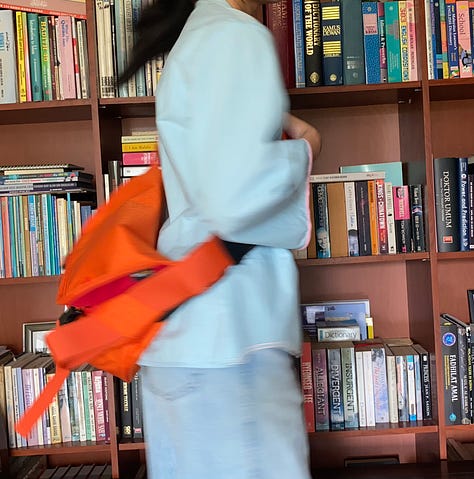
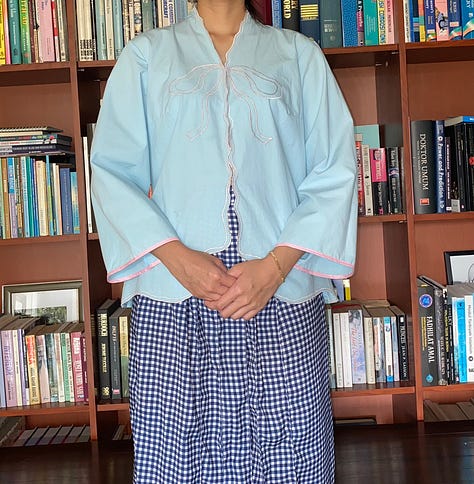
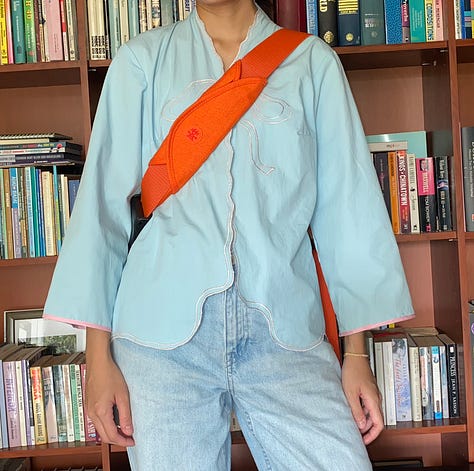
I haven’t got around to wearing it out yet as I am saving it for a very special occasion, so I cannot speak too much on it. But I have two initial thoughts: the awkward positioning of the buttons make it a challenge to button-up the top and while I understand that these clothes are being handmade by a very small team in a short amount of time, it would have made the whole piece finer if the loose threads were cut off.
Either way, I look forward to flaunting my Mignonne.
On being a young designer in Malaysia
Their latest collection is quickly gaining traction from customers online and offline, but success has not always come easily for Rafiz. The young designer told me that after his first collection flopped, he went through a depressive episode where he ceased to come up with anything for months. It was not until he got a call from NONA TV3, who wanted to do a feature on Rumah Hartiqa, that he took it as a sign to start designing again. From then on, things started to turn around for Rafiz and the brand, and he has since produced four unique collections.
See what I mean when I say it’s important to support up-and-coming designers?
Despite the challenges and the fears (Rafiz says he still gets scared sometimes even as they enter their third year in the game), Rafiz is marching on, and to the beat of his own drums at that. It is not easy being both young and brave, but he is doing it, and I can’t wait to see what else this promising designer has to offer.
Thank you so much to Rafiz for sitting down with me on that quiet Wednesday afternoon and sharing his stories. Thank you also to Wawa and Haziq, whom I had the pleasure of chatting with briefly at the market.
You may find Rumah Hartiqa on Instagram here.




